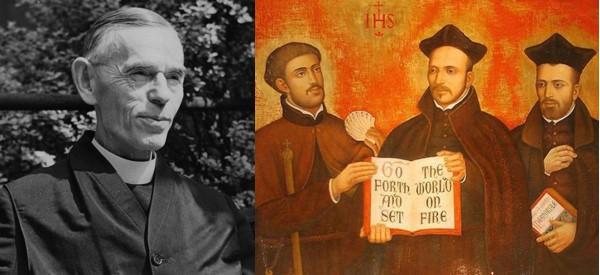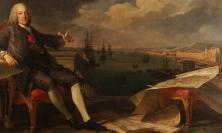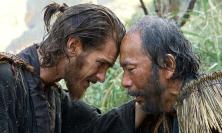If the Society of Jesus was founded to help souls, the souls of those outside the Society, why have Jesuits always been so determined to tell their own story? As Thomas Flowers SJ celebrates the work of Jesuit historian James Brodrick, he discovers that ‘Jesuit history is not about glorying in the past triumphs of the Society. Rather, Jesuit history is about teaching Jesuits to be better Jesuits, and all Christians to be better followers of Christ.’
In 1960, looking back over fifty years of Jesuit life, James Brodrick composed a rather melancholic poem reflecting on how little fruit he had produced in all those years. He wondered,
And my kind saints, Ignatius, Francis, Peter,
On whom I spent in floods my sweat and ink
And found down even in the depths the sweeter,
What must you now and dear Roberto think?[i]
To the several generations of Jesuits all over the world who learned the early history of the Society in the wry, but somehow still reverent, tones of Brodrick’s prose, such self-recrimination seems sadly misplaced. What so many of us remember of the lives of Robert Bellarmine and Peter Canisius (the ‘Roberto’ and ‘Peter’ of the poem) came to us through Brodrick’s monumental biographies of them written in 1928 and 1935, respectively, biographies that remain unmatched, despite so many intervening decades of historical scholarship. Brodrick’s 1940 The Origin of the Jesuits and 1946 The Progress of the Jesuits can seem, in the light of the more recent scholarship of books like John O’Malley’s The First Jesuits, overly hagiographic, but they tell a compelling story, and one that nurtured the vocation of many a novice for many a year. Yet as we approach the fifty-year mark since Brodrick’s death in 1973, the progress of historical scholarship and changing sensibilities mean that fewer Jesuits and lay people read Brodrick’s books, and so fewer and fewer know his name. This is only natural, but his name is one worth remembering, not just because he was a good and faithful servant of the Lord and the Society, but because of what his work still represents for us today: a loving look into what the early Jesuits can teach us about how to be faithful to Christ’s mission.
Born on 26 July 1891 in Galway in Ireland, Brodrick entered the English Province of the Society in 1910. Ordained a priest in 1923, he was missioned to London in 1924 to work as a writer for the then-thriving periodical of the Jesuits in Britain, The Month. It must have been about this time that he made his first forays into writing the history of the Society, since his two-volume, prodigiously researched and footnoted biography of Robert Bellarmine appeared a mere four years later. In addition to the books mentioned above, Brodrick also wrote The Economic Morals of the Jesuits (1934), Saint Francis Xavier (1952), Saint Ignatius Loyola: The Pilgrim Years (1956) and Galileo: the Man, His Work, His Misfortunes (1964). A debilitating heart attack in 1967 ended his literary career some six years before his death.
His obituarist noted in The Times that he ‘made his great contribution to Roman Catholic tradition in Britain by rescuing the early Jesuit saints from the apologists and hagiographers and subjecting them to historical criticism. In the process he also brought them to life’.[ii] To one who opens the pages, for example, of Saint Peter Canisius today, such laud for Brodrick’s scholarly approach may seem overly generous. Not only does Brodrick refer to Canisius throughout, in what seems today quite unscholarly fashion, as ‘the Saint’, but he frankly recounts such pious stories as that of the holy woman who prophesied to the boy Peter that he would one day join a ‘new order of priests about to come into existence’ with nary a critical remark.[iii] Yet Brodrick’s own very real piety and devotion to the saints about whom he wrote should not diminish the significance of his contribution to scholarship and to the Society with these books. Indeed, if anything, they might remind us of the endeavour in which he was truly engaged.
In 1598, Superior General Claude Acquaviva sent a letter to all the Jesuit provinces in the world giving instructions for the preparation of historical materials that he hoped would enable the production of a general history of the Society of Jesus. Acquaviva requested that each province appoint an official historian who could begin gathering the necessary materials for a formal history of the province. The result of this effort was not only such works as the 1640 monumental Imago Primi Saeculi Societatis Iesu, celebrating the first hundred years of the Society, but the gathering and organising of historical materials that continue to make the history of the Society an attractively well-documented field for historians today. Even before this, the Society had long been interested in preserving the story of its origins and progress: several of the early Jesuits – among them the first companion Simão Rodrigues and Ignatius’s long-time secretary, Juan Polanco – wrote histories, of one sort or another, of the founding and early years of the Society. We might ask ourselves, looking back both on the multiplicity of first-hand accounts of the Society’s origins and on Acquaviva’s directives for writing an ‘official’ history of the Society, why Jesuits seem to have always been so interested in telling their own story. After all, the Formula of the Institute assures us that the Society was ‘founded chiefly for this purpose: to strive especially for the progress of souls in Christian life.’[iv] In other words, the purpose of the Society is to help other people – to help non-Jesuits – and so the persistent interest of Jesuits in themselves can almost seem a contradiction of the very purpose of the Society; surely the men tasked with writing Jesuit history could have spent their lives more fruitfully helping souls through preaching, teaching, spiritual conversation, or caring for the poor and sick? th
Perhaps this is exactly what occurred to James Brodrick fifty years into his Jesuit life when he spoke in verse to his guardian angel and beloved saints, declaring that ‘the harvest that you hoped to reap / by all your tears upon this barren field’ had amounted to no more than a ‘mocking yield’. He had spent the better part of his life and ministerial energy relating what one might easily compare to family history – a story that might serve as a curiosity for those outside of the family, but that could be easily dismissed as lacking any practical, ministerial usefulness.
Yet Brodrick’s ministry, and Jesuit history in general, are, at their best, profoundly apostolic.
The key to understanding why the early Jesuits worked so hard to preserve the memory of the founding of the Society, why Fr Acquaviva desired the construction of a general history of the order, and why Brodrick’s work has mattered to so many over the years – and still matters to those of us who know it – lies in recognising what the history of the Society still has to offer us today. Jesuit history is not about glorying in the past triumphs of the Society or praising our forebearers for their magnificence, and Brodrick understood that well. Rather, Jesuit history is about teaching Jesuits to be better Jesuits, and all Christians to be better followers of Christ, not through painting the past in rosy colours, but through telling the truth about the love and the labours, the faith and the doubts, the hope and the failures of the members of the Society of Jesus as they struggled to follow where the Spirit of the Lord led them. In the end, by painting a picture of the reality of our past, Jesuit history serves as a source of consolation and formation for our future.
When Brodrick wrote Saint Ignatius Loyola: The Pilgrim Years, he intended it to be the first in a series on the life of Ignatius. That book concluded with Ignatius’s journey to Rome in 1537 and a brief mention of him celebrating his first Mass in Rome in 1538 – and thus, before the actual founding of the Society in 1540. And although Brodrick never did manage to publish a follow-up to that work, in the archives of the Jesuits in Britain, in a worn notebook, the opening chapters of a second volume on Ignatius exist, written out in Brodrick’s clear hand. The first chapter was to be called ‘A Cottage in a Vineyard’, and began with the following words: ‘At the turn of Nov[ember] in the year 1537, three tired and timid men, priests in poor black robes carrying on their backs their entire worldly possessions, passed unnoticed through the half-ruined Porto del Popolo into the City of Rome.’[v] By the close of that first paragraph, the identities of these three have been revealed: Ignatius, Diego Lainez and Pierre Favre. In that one line, Brodrick reveals much about what fruit his labours bore. With an easy, welcoming style, Brodrick intended to invite the readers of that book to accompany three entirely human, ‘tired and timid men’ as they doggedly sought to pursue the greater glory of God. Figures like Ignatius and Favre seem larger than life to most Jesuits, and the witness of their lives easily intimidates us: how could we possibly measure up? And so Brodrick, with the deft knack of a consummate storyteller, invited us to share their journeys and tables and prayers, so that we could come to see that these ones through whom God had done great things were, in fact, quite as human as we are.
This humanising effort of Brodrick’s perhaps appears in his writing no more starkly than in his final evaluation of Peter Canisius, in which he declares that, ‘in spite of’ Canisius’s manifold limitations as a writer and a scholar, in spite of the fact that whatever cross-section of him we take we come upon nothing but what might be called sublime mediocrity, he was unquestionably a very great man. It was the integrity of his character that made him such, marshalling his average powers and giving them a glow and forcefulness utterly beyond their inherent worth.’[vi] I, myself, think that Canisius was much more than a mediocre scholar and writer, but I nonetheless appreciate what Brodrick accomplishes by these conclusions: he summons the stern provincial, catechist and preacher down from the pedestal to which our admiration had elevated him so that he might sit beside us and share his faith and his wisdom not as our hero, but as our brother. Having been consoled by Peter’s limitations that remind us of our own, it is easier to allow his witness to come alive for us, to inspire us in an entirely companionable way.
I remember well when I first read Saint Peter Canisius as a novice, and the impact it had on me. During my first year as a Jesuit, I felt continually out of place, as if I had perhaps misunderstood the Society I thought I was joining. But Peter Canisius helped convince me to stay. Brodrick introduced us, and then I heard, a few months later, a moving talk on Jesuit mission by Tom Lucas SJ that used Peter Canisius as one of the models. And so slowly, Peter showed me a way to be a Jesuit that made sense to me: from his prayer to his teaching, from his preaching to the tender care he showed to his brother Jesuits, I saw in Peter the life for which I was looking. And, with the help of James Brodrick and Tom Lucas to tell me the story and bring it to life, I saw that Peter’s Society of Jesus was alive and well around me. So I stayed, and still look to Brodrick’s ‘kind saints’ when I need help to go forward. The fields he sowed by his storytelling continue to bear fruit.
Thomas Flowers SJ is a member of the USA West Jesuit Province and is studying for a PhD in Jesuit History at the University of York.
[i] The original hand-written text of this poem can be found in the Archives of the British Province of the Society of Jesus in the collection of the papers of James Brodrick, carton 30/5/2.
[ii] The Times (28 August 1973).
[iii] See Brodrick, Saint Peter Canisius (London, 1935), p. 10.
[iv] This translation of the 1540 Formula can be found in The Constitutions of the Society and their Complementary Norms: A Complete English Translation of the Official Latin Texts, ed. John Padberg SJ (Saint Louis, 1996), p.3.
[v] Archives of the British Province of the Society of Jesus, the papers of James Brodrick, carton 30/5/2.
[vi] See Brodrick, Saint Peter Canisius, p.819.






